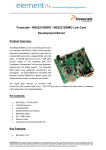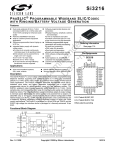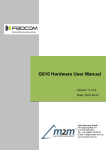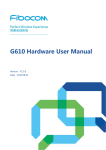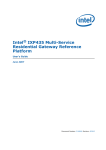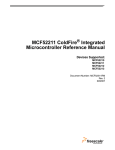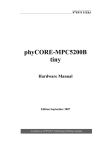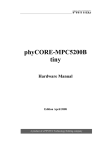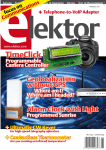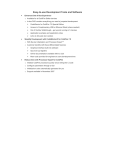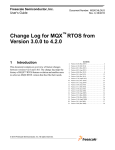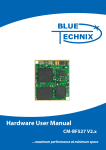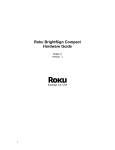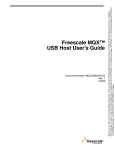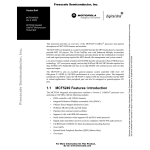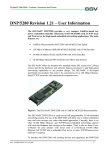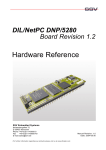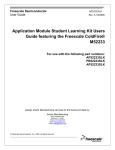Download M54451EVBUM M54451EVB Hardware User Manual
Transcript
D O C - 0 4 3 9 - 0 1 0 , R E V . D M54451EVB Development Board for Freescale MCF54451 MCU Hardware User Manual PRELIMINARY ٛ Axiom Manufacturing • 1226 Exchange Drive • Richardson, TX 75081 Email: [email protected] Web: http://www.axman.com ٛ M 5 4 4 5 1 E V B U S E R M A N U A L 0 1 / 1 5 / 0 9 CONTENTS CAUTIONARY NOTES .......................................................................................................................... 2 TERMINOLOGY ..................................................................................................................................... 2 FEATURES ............................................................................................................................................... 3 REFERENCE DOCUMENTATION ...................................................................................................... 4 M54451EVB STARTUP........................................................................................................................... 4 M54451EVB HARDWARE SUMMARY ............................................................................................... 5 MCU APPLICATION .................................................................................................................................. 5 SWITCH SUMMARY ................................................................................................................................... 5 INDICATOR SUMMARY .............................................................................................................................. 6 EXTERNAL CONNECTION SUMMARY......................................................................................................... 6 OPTION JUMPER SUMMARY ...................................................................................................................... 7 HARDWARE APPLICATION ........................................................................................................................ 8 Memory................................................................................................................................................. 8 System Clocks....................................................................................................................................... 8 Stereo Audio CODEC........................................................................................................................... 8 10/100TX Ethernet Port – J1 ............................................................................................................... 9 USB Mini A/B OTG Port – J2 .............................................................................................................. 9 FXO and FXS Ports.............................................................................................................................. 9 EVB POWER SUPPLIES ..................................................................................................................... 9 EVB Development Ports....................................................................................................................... 9 EVB OPERATION ................................................................................................................................. 10 EVB POWER SELECTION AND OPTIONS ........................................................................................... 10 Power Jack (PWR) ............................................................................................................................. 10 Power Over Ethernet (POE) Supply .................................................................................................. 10 POE_ON Indicator............................................................................................................................. 10 PWR_SEL Option............................................................................................................................... 10 +5V Indicator..................................................................................................................................... 11 TB1 - +5V and Ground Access .......................................................................................................... 11 F1 - Fuse ............................................................................................................................................ 11 ON_OFF Switch................................................................................................................................. 11 +3.3V, +1.8V, and +1.5V Indicators ................................................................................................. 11 JP13, JP14, JP15 - U1 Power Enable ............................................................................................... 11 EVB START-UP AND OPTIONS.......................................................................................................... 12 BOOT_0, BOOT_1 Options ............................................................................................................... 12 JP3 – Serial Flash Memory Select Enable......................................................................................... 12 RESET Switch..................................................................................................................................... 12 RESET Indicator ................................................................................................................................ 12 1 M 5 4 4 5 1 E V B U S E R M A N U A L 0 1 / 1 5 / 0 9 Cautionary Notes 1) Electrostatic Discharge (ESD) prevention measures should be applied whenever handling this product. ESD damage is not a warranty repair item. 2) Axiom Manufacturing reserves the right to make changes without further notice to any products to improve reliability, function or design. Axiom Manufacturing does not assume any liability arising out of the application or use of any product or circuit described herein; neither does it convey any license under patent rights or the rights of others. 3) EMC Information on the M54451EVB board: a) This device complies with Part 15 of the FCC Rules. Operation is subject to the following two conditions: 1) This device may not cause harmful interference, and 2) This device must accept any interference received, including interference that may cause undesired operation. b) This product as shipped from the factory with associated power supplies and cables, has been tested and meets with requirements of CE IT Equipment CLASS A product. c) This product is designed and intended for use as a development platform for hardware or software in an educational / professional laboratory. d) In a domestic environment this product may cause radio interference in which case the user may be required to take adequate prevention measures. Terminology This development board applies option selection jumpers. Terminology for application of the option jumpers is as follows: Jumper on, in, or installed = jumper is a plastic shunt that fits across 2 pins and the shunt is installed so that the 2 pins are connected with the shunt. Jumper off, out, or idle = jumper or shunt is installed so that only 1 pin holds the shunt, no 2 pins are connected, or jumper is removed. It is recommended that the jumpers be placed idle by installing on 1 pin so they will not be lost. Signal names in this document that are followed by an asterisk (*) denote an active-low signal. 2 M 5 4 4 5 1 E V B U S E R M A N U A L 0 1 / 1 5 / 0 9 FEATURES M54451EVB is a low cost development or evaluation system for the Freescale MCF54451 ColdFire® microcontroller. EVB features are aimed at VOIP or similar application solutions. An integrated USB BDM development port is provided on board for development assistance. The supporting MCF52211 MCU provides an I/0 application coprocessor with a device USB port. ♦ ♦ ♦ ♦ ♦ Features: ♦ MCF54451 MCU, 256 MAPBGA * 240Mhz operation * 32K Byte single cycle SRAM * DDR, DDR2, Mobile DDR Controller * 16 channel DMA Controller * XBS Crossbar Switch w/ multiple ports * USB OTG Controller w/ ULPI bus * Integrated 10/100 FEC * SPI w/DMA (DSPI), IIC, and SSI/I2S Serial Ports * 2 UART Serial Ports with DMA capability * 4 Interrupt Inputs * 4 PIT timers * 4 32 bit Timers w/ DMA * BDM / JTAG Port * Serial Boot capability * Internal Oscillator w/ PLL clocking * 3.3V / 1.5V operation ♦ ♦ ♦ ♦ ♦ ♦ ♦ ♦ ♦ ♦ 3 128MByte Mobile DDR 16MByte Parallel flash and 8MByte Serial flash USB OTG PHY on ULPI bus 10/100TX Port on RMII bus w/ POE power supply Stereo Audio CODEC w/ Line I/O and MIC 3.5mm Jacks FXS CODEC w/ DAA Phone Connection FXO CODEC w/ DAA Subscriber Line Connection Support MCF52211 MCU w/ USB connection On-Board USB BDM Development Port SD Card connector RESET and ABORT (IRQ7) push switches 8 User and 2 10/100TX Status Indicators (LED) MCU I/O Port Connectors, 2 x 50 pins External BDM / JTAG Port, 26-pin development port Regulated +3.3V / 1.8V / 1.5V power supplies w/ indicators M 5 4 4 5 1 E V B U S E R M A N U A L 0 1 / 1 5 / 0 9 Kit content: Supplied with 10/100 Ethernet cable, 5VDC Wall Adapter Power Supply, USB A/B cables, Quick start and Support CD media. Specifications: Board Size 5 x 6 inches w/ 4 corner mounting holes Power Input: +4.5 - +5.5VDC, 5.0VDC typical POE supply Input: 48V typical, 5V output Current Consumption: 300ma typical @ 5VDC input The M54451EVB is provided operating a demonstration application. Refer to the M54451EVB Quick Start Guide for more information on default operation. The EVB kit is plug in and play as delivered with a global wall adapter power supply, cables, support CD, and example software. Additional hardware and software development tools are available, but not required. Reference Documentation The following documents should be referenced when developing with the M54451EVB. These documents are available on the MCF54451 and M54451EVB web pages (http://www.freescale.com/coldfire). M54451EVBUM – This user manual. MCF54455RM – MCF54451 Device Reference Manual CFPRM – ColdFire Programmers Reference Manual with instruction set M54451EVB_SCH_D – M54451EVB board schematics M54451EVB Startup Follow these steps to connect and power on the board 1) Carefully unpack the M54451EVB and observe ESD preventive measures while handling the M54451EVB development board. 2) Review the Quick Start guide and option settings on the EVB. 3) Install supporting software prior to connecting the USB ports. Review the support CD(s) and copy documentation or install software as wanted. 4) Connect necessary cables between host PC and EVB board prior to applying power to the EVB. 5) Apply power to the development board by installing the +5.0VDC wall plug power supply between a wall outlet and the PWR Jack on the board. The +5VDC indicator should be ON. Set the ON / OFF switch to the ON position. The EVB +5, 3.3V, 1.8Vand 1.5V voltage indicators should turn on at this time. Note: PWR_SEL = PWR setting default, see the POE section for operating the POE supply. 6) Follow the Quick Start for preloaded application operation or launch development tools. 7) The board is ready to use now. 4 M 5 4 4 5 1 E V B U S E R M A N U A L 0 1 / 1 5 / 0 9 M54451EVB Hardware Summary The M54451EVB board provides an enhanced development or evaluation platform for the MCF54451 microcontroller. Following are descriptions of the primary components and EVB application. MCU Application The MCF54451 is applied with features supporting the many interfaces available on the device. Also provided is a supporting MCF52211 MCU operating as a support processor. Following is a summary of the applied hardware: • USB OTG Mini A/B port (J2) supported by MCF54451 ULPI bus and a USB3300 ULPI PHY device. • 10/100Tx Ethernet port supported by MCF54451 FEC0 in RMII mode, KSZ8041 PHY, X1 50Mhz clock, Connector J1, and Power Over Ethernet (POE) power supply input. • Mobile DDR Ram 64M x 16 supported by MCF54451 SDRAM Controller. • Parallel Flash Memory 8M x 16 supported by MCF54451 Flex Bus (28F128P33). • Serial Flash Memory 8M byte supported by MCF54451 DSPI / Serial Boot facility and the MCF52211 support MCU. • SDCARD connector supported by MCF54451 DSPI. • Telephony FXS and FXO ports supported by MCF54451 SSI and DSPI, and the Si3210 and Si3050 integrated solutions. • Stereo Audio CODEC (TLV320AC23) supported by MCF54451 SSI and DSPI. • Support MCU (MCF52211) with USB client port, and DSPI or development port access to the MCF54451. • Eight Indicators for application use. Switch Summary Indicator ON / OFF RESET U4_RESET ABORT Purpose EVB power on and off Reset MCF54451 (U1) Reset MCF52211 (U4) NMI /IRQ7 MCF54451 Operation Notes Enables EVB voltage regulators when ON. Applies MCF54451 RSTIN* signal active. Applies MCF52211 RSTIN* signal active. Applies MCF54451 IRQ7/NMI signal low (application must enable and support). 5 M 5 4 4 5 1 E V B U S E R M A N U A L 0 1 / 1 5 / 0 9 Indicator Summary Indicator RESET U4_RESET +1.5V +1.8V +3.3V +5V POE_ON LED1 – 4 LED5 – 8 LNK_ACT SPD D501 D502 Purpose Reset Indication (Red) Reset Indication (Red) +1.5V Voltage (Green) +1.8V Voltage (Green) +3.3V Voltage (Green) +5V Voltage (Green) POE +5V Voltage (Green) User / App (Green) User / App (Green) Ethernet Status (Green) Ethernet Status (Green) Embedded BDM Status (Green) Embedded BDM Status (Yellow) Indication Notes U1 - MCF54451 RESETOUT* is active. U4 - MCF52211 RSTOUT* is active Power supply 1.5V is present. Power supply 1.8V is present. Power supply 3.3V is present. +5V input supply is present. +5V from POE supply is available. U4: Port AN0 – 3 is high level. U1: Port DT0-3IN is high level. 10/100Tx PHY has Link or Activity 10/100Tx PHY is in 100Mbs mode. Target power detected (D502 must be on). J501 USB connected, BDM is active. External Connection Summary Connector J1 J2 Purpose 10/100Tx Ethernet / POE USB OTG Mini A/B J3 J501 PWR (Jack) TB1 (not populated) F1 Fuse LINE_IN U4 USB-B BDM USB-B External +5V input Alternate +5V input or output 5 x 20mm fuse clips Stereo CODEC input LINE_OUT Stereo CODEC output Stereo CODEC input FXS Phone I/O FXO Office Line I/O SD memory card or SDIO device I/O Signal access MIC_IN PHONE LINE SDCARD IO_PORT1 / 2 BDM_PORT U4_BDM J4 J5 J6 U1 External BDM U4 External BDM ULPI Bus access ULPI Bus access SSI Bus access Application Notes Applies MCF54451 Ethernet connection and POE power supply input. Applies MCF54451 ULPI type USB 2.0 host or client port. MCF52211 USB client port for support applications. Embedded USB BDM port. Primary +5V input application to power the EVB. Alternate connection to +5V input supply. 2A fuse connection for primary +5V supply. 3.5mm Audio input jack (Line-In and Line-Out looped back if plug is not installed). 3.5mm Audio output jack (Line-In and Line-Out looped back if plug is not installed). 3.5mm Microphone input jack. RJ11 Phone / Handset connection. RJ11 Office Subscriber Line connection. SDCARD or SDIO connection. Operates in simple mode under MCF54451 control. MCF54451 Flex Bus and GPIO access ports. MCF54451 External BDM Port. (Do not apply at same time as the Embedded USB BDM.) MCF52211 BDM port for application loading. MCF54451 ULPI bus signal access. MCF54451 ULPI bus signal access. MCF54451 SSI / I2S bus signal access. 6 M 5 4 4 5 1 E V B U S E R M A N U A L 0 1 / 1 5 / 0 9 Option Jumper Summary Option PWR_SEL Purpose +5V input source select ULPI clock enable Default PWR Application Notes Selects PWR jack / TB1 or POE supply input 1-2 Select MCF54451 Boot mode MCF54451 BDM Port Mode BDM_PORT Mode MCF52211 U4_BDM Port Mode U4 SPI Select Installed 1-2 position applies 40Mhz USB ULPI clock to MCF54451 USB clock input. 2-3 position removes clock. Both Installed = Flex Bus / parallel Flash default. Both open / idle = Serial Boot Mode. Open / Idle = MCF54451 BDM Mode Installed = MCF54451 JTAG Mode 1-2 Position selects BDM Port JTAG mode. 2-3 Position selects BDM Port BDM mode. Installed = MCF52211 BDM Mode Open / Idle = MCF52211 JTAG Mode Serial Flash Select enable Stereo CODEC SSI enable +VDC enable SDCARD Select Installed Installed JP12 Stereo CODEC Select enable 10/100 PHY IRQ FXO CODEC Select enable FXS CODEC Select enable FXO/FXS IRQ1 Enable U4_BDM Mode JP13 MCF54451 3.3V Installed JP14 MCF54451 1.5V Installed JP15 MCF54451 1.8V Installed USB_CLK BOOT 0 /1 JTAG_EN BDM_MODE JP1 JP2 JP3 JP4 JP5 JP6 JP7 JP8 JP9 JP10 JP11 U4_MODE1/2 U4 Application Idle 2-3 Installed 1-2 Installed Installed 1-2 Installed Installed Installed Installed Open Installed 1-2 = U4 / MCF52211 QSPICS0 select on MCF54451 DSPICS0 signal. 2-3 = U4 / MCF52211 QSPICS0 select on MCF54451 DSPICS1 signal. MCF54451 DSPICS1* / Serial Boot chip select enabled to the serial flash. Enable CODEC SSI Bus data output. Enable EVB +5V to FXS port = +VDC supply 1-2 = MCF54451 DSPICS0 signal selects SDCARD. 2-3 = MCF54451 DSPICS1 signal selects SDCARD. MCF54451 DSPICS5 select enabled to the Stereo CODEC. MCF54451 IRQ3 input assigned to 10/100 Ethernet PHY. MCF54451 DSPICS3 select enabled to the FXO CODEC. MCF54451 DSPICS2 select enabled to the FXS CODEC. MCF54451 IRQ1 input assigned to the FXO/FXS CODEC’s and DAA’s. Option not installed, U4_BDM Port = BDM mode. MCF54451 +3.3V supply enable, ALWAYS Install MCF54451 +1.5V core supply enable, ALWAYS Install MCF54451 +1.8V SDRAM supply enable, ALWAYS Install U4 application support, refer to application. 7 M 5 4 4 5 1 E V B U S E R M A N U A L 0 1 / 1 5 / 0 9 Hardware Application Memory The internal MCF54451 device SRAM, EVB Mobile DDR memory, EVB Parallel Flash memory, EVB Serial Flash memory, and EVB SDCARD connections provide the development and application memory banks. The MCF54451 provides internal 32K bytes of high speed SRAM for DMA and Cache memory space. Refer to the MCF54455 device user guide for device details. The MCF54451 SDRAM controller is dedicated to U2, the EVB 128MByte Mobile DDR Ram memory. The Mobile DDR ram device is a Micron MT46H64M16. MCF54451 Flex Bus application on the EVB is a single 16MByte parallel flash (Ny28F128P33) assigned to chip select FB_CS0*. The flash may be applied as application program and boot memory or storage memory. The Flex Bus may be applied as GPIO at the I/O PORT connectors if the flash application is not desired. Refer to EVB Start-up Options for configuring the Boot and memory selection. Serial Flash of 8MBytes is provided for DSPI access or as an optional boot memory device. SDCARD connection is provided for memory expansion or addition of peripheral features. System Clocks The EVB provides the MCF54451 a 24MHz crystal oscillator reference for typical application operation at 240Mhz. The Mobile DDR ram operates at 120MHz and the Flex Bus at 60Mhz maximum clock rate. USB and Ethernet clock rates and EVB application are provided in the respective sections of this manual. SSI CLOCK: The Y5 Crystal location provides default 12.288Mhz clock frequency for the SSI clock input to the MCF54451 IRQ4 / SSI clock pin. This frequency may be changed by replacing the crystal with a similar 20pf parallel load type with a frequency between 8 and 16Mhz. Refer to the MCF54451 SSI reference manual for more details on operation. Stereo Audio CODEC The EVB provides a TLV320AC23 Stereo Audio CODEC for stereo audio applications via the MCF54451 SSI / I2S serial bus. The CODEC is supported by three 3.5mm (1/8”) jacks for Microphone, Line IN and Line OUT audio connections. Note that the Stereo CODEC may not operate at the same time as the FXS/FXO telephony CODECs. Refer to the demonstration application for operation details. 8 M 5 4 4 5 1 E V B U S E R M A N U A L 0 1 / 1 5 / 0 9 10/100TX Ethernet Port – J1 The 10/100TX Ethernet physical interface connection and the Power Over Ethernet (POE) supply input are applied by RJ45 connector J1. Port configuration applies the MCF54451 Fast Ethernet controller (FEC) and KSZ8041 PHY operating in RMII mode. The coupling transformer T1 provides port isolation and the input power path to the POE supply. Clock oscillator X1 provides the 50MHz clock source for the PHY and FEC communication. USB Mini A/B OTG Port – J2 This USB 2.0 host or device mode port is provided by the MCF54451 ULPI bus and USB3300 PHY device. MCF54451 USB port signal pins USBD- / USBD+ are not applied by the EVB and are provided on the I/O PORT connectors. The ULPI PHY applies a 24Mhz reference crystal oscillator to generate the 40Mhz ULPI bus clock. Host mode operation is supported by device power output switch, U8. FXO and FXS Ports The EVB provides a FXO Line interface and a FXS Station interface with integrated CODEC’s and DAA’s. These ports are to be considered development application use only and are not qualified to be permanently attached to a public or private network. The FXS Phone / Station port will provide up to 48V phone battery supply and ringing voltages. The FXO Line / Office port accepts a standard subscriber line interface and ringing input signals. EVB POWER SUPPLIES The EVB provides three regulated power supplies from a regulated +5VDC input supply. The +5V input is provided by the PWR Jack or Power Over Ethernet (POE) power supply. Both power supplies may be powered on at the same time but only one may be applied to power the EVB board. The PWR_SEL option jumper selects which power supply will operate the EVB board. Default application is for regulated +5VDC to be applied by external connection to the Power Jack (PWR). The ON _OFF switch enables the regulated 3.3V, 1.8V and 1.5V supplies to the EVB circuits. EVB Development Ports The EVB provides an embedded USB BDM and external BDM_PORT for the MCF54451. Support processor U4 (MCF52211) has a U4_BDM_PORT for application loading. 9 M 5 4 4 5 1 E V B U S E R M A N U A L 0 1 / 1 5 / 0 9 EVB OPERATION EVB POWER SELECTION and Options Power Jack (PWR) The Power Jack provides the default +5VDC power input to the board. The jack accepts a standard 2.0 ~ 2.1mm center barrel plug connector (positive voltage center) to provide the +5V supply of +4.5 to +5.5 VDC (+5.0VDC typical). +Volts, 2mm center Power Over Ethernet (POE) Supply The POE supply (Freescale MC34670) input is from the J1 Ethernet connector. A POE enabled Ethernet switch or host equipment provides the supply for this input. The POE_ON indicator will be ON if this supply is available. This is an isolated type supply, test pads +VE and –VE must not be grounded by test equipment or EVB signal connections, damage may occur. POE_ON Indicator The POE_ON indicator will light if the Ethernet POE supply is powered and operating. PWR_SEL Option PWR_SEL option jumper provides selection of the PWR Jack input or POE supply input to power the EVB board +5VDC source. Default position is for PWR jack to provide power. PWR_SEL PWR Jack Input PWR_SEL POE Supply Input 10 M 5 4 4 5 1 E V B U S E R M A N U A L 0 1 / 1 5 / 0 9 +5V Indicator The +5V indicator will be ON if a +5V source is available from the PWR Jack or POE supply. The PWR_SEL option must also be installed to select the correct input supply. If a +5V supply is provided and the +5V indicator is not ON, check fuse F1 and review for power issues. TB1 - +5V and Ground Access TB1 is not populated by default. The TB1 position and PCB pads provide access to the same connections as the PWR Jack. +5V applied at the PWR Jack may be accessed at the TB1 location. TB1 location may apply a +5V supply to the EVB board if the PWR Jack is not applied. F1 - Fuse F1 is populated by a 5x20mm 2Amp fuse. The fuse is applied between the +5V input from the PWR jack or POE supply and the EVB board circuits. If +5V or POE supply is applied to the EVB and the +5V Indicator is not ON, the fuse should be checked and replaced if required. Fuse failure may indicate an EVB failure, user should review connections and application for possible cause. ON_OFF Switch The ON_OFF switch provides power On and Off control for the EVB 3.3V, 1.8V and 1.5V voltage regulators. All voltage indicators should be ON with the switch in the ON position (power applied). ON OFF +3.3V, +1.8V, and +1.5V Indicators These indicators will be ON if the associated power supply is powered and operating. Refer to the PWR_SEL, F1 fuse and ON_OFF switch settings for additional information. JP13, JP14, JP15 - U1 Power Enable These options must be installed at all times the EVB is operating. Options are provided for MCF54451 / U1 operating power or operating voltage range measurements. Users should not remove the options jumpers or disconnect / idle the options. 11 M 5 4 4 5 1 E V B U S E R M A N U A L 0 1 / 1 5 / 0 9 EVB START-UP and OPTIONS This section provides the MCF54451 Reset configuration and primary boot memory selection options. In parallel boot mode the MCF54451 will apply the default reset configuration and FB_CS0* chip select to access the EVB parallel flash. The flash memory content must provide the exception / interrupt vectors and initialization procedure. In serial boot mode all necessary configuration settings for the MCF54451 to exit the Reset state must be provided in the serial data content. Refer to the MCF54455 Reference Manual for an in-depth description of the boot sequences. BOOT_0, BOOT_1 Options The BOOT_0 and BOOT_1 options provide the Boot Mode from RESET for the MCF54451. Both options must be set to the same option position, no other option positions are supported on the EVB. Both options open / idle provide for Serial Boot mode from the EVB serial flash memory. Note that JP2, JP3, and JP6 options must be set to allow only JP3 to be placed on the DSPICS1 signal. BOOT_0 and BOOT_1 options installed provide for Flex Bus parallel memory Boot. Reset Mode Parallel Serial Boot_0 / Boot_1 Installed Open / Idle JP2 N/A 1-2 JP3 N/A IN JP6 N/A 1-2 Boot Memory EVB Parallel Flash – U21 EVB Serial Flash – U13 JP3 – Serial Flash Memory Select Enable JP3 installed connects the MCF54451 DSPICS1 / Serial Boot Select signal to the Serial Flash Memory device U13/14. Only one peripheral should be applied by the DSPICS1 signal. User should review option setting of JP2 and JP6 prior to application. RESET Switch RESET switch provides for manual application of the MCF54451 RSTI* input signal. The MCF54451 will drive the RSTOUT* signal to reset the EVB board peripherals. This signal will be enabled for 150ms after release of the Reset switch. RESET Indicator RESET indicator will be ON for the duration of the MCF54451 RSTO* signal. This operation indicates the MCF54451 is in the Reset state. 12













